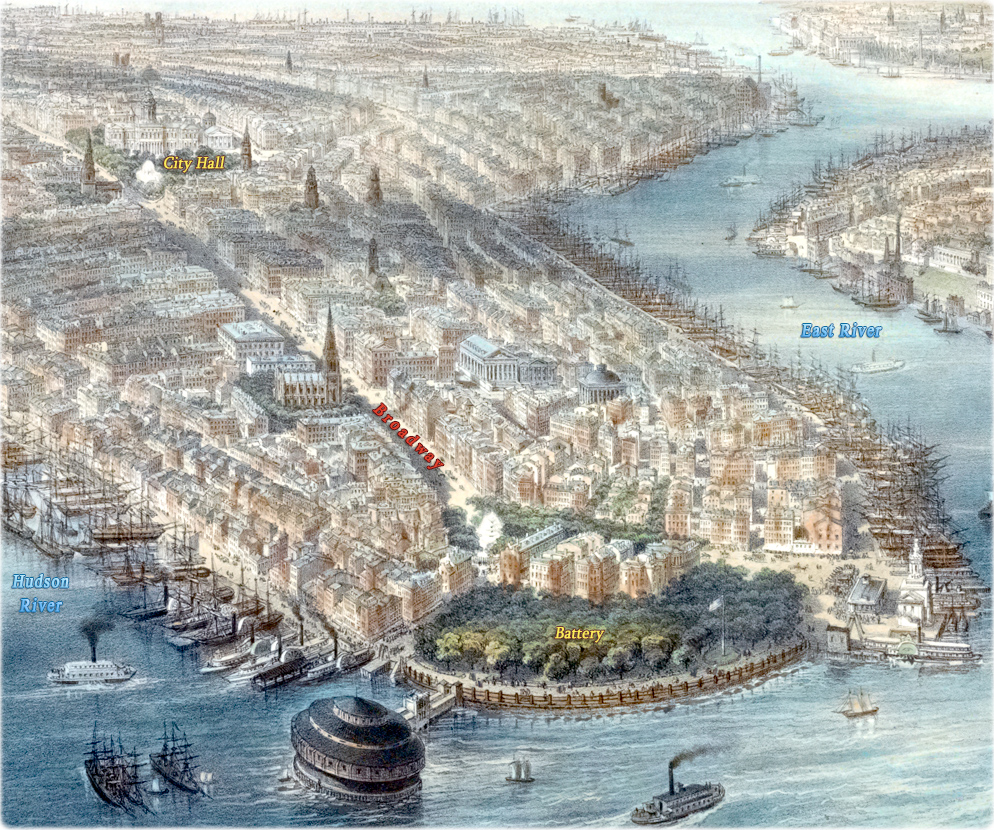
Manhattan in the 19th Century
The population of the City of New York in 1800 was 60 thousand inhabitants and 185 thousand in 1830. Manhattan entered the 19th century at a pace of development and urban expansion towards the north of the Manhattan Island. In 1811, the modern street grid of Manhattan was introduced by the Commissioners’ Plan.
The completion of Erie Canal in 1825 cemented the position of New York as the preeminent commercial city in the country.
In 1835, Lower Manhattan was hit by a huge fire, destroying many buildings. Another great fire happened in 1845.
In 1842, the Croton Aqueduct was completed, carrying water by gravity from the Croton Watershed. A new Croton Aqueduct opened in 1890.
In 1845, the first telegraph lines began to be constructed in New York. By 1846, New York City was connected via telegraph to Philadelphia, Boston, Albany, and Washington. The telegraph frenzy continued into the 1880s, then the telephone boosted the communication business. At that time, overhead wires made the urban landscape ugly and the city forced the removal of wires with the installation of underground networks for telegraph, telephone and electricity. The last overhead wires in Manhattan were removed in 1904.
In 1851, the New York and Hudson River Rail Road Company began rail service to Albany from their new terminal on East Broadway, between Chambers and Warren Streets. In 1870, the first elevated railroad of opened in Manhattan: the Ninth Avenue Line. In 1871 the Grand Central Depot of the New York Central Railroad was opened at 42nd Street, on the site of the present terminal. In 1889, electric traction streetcars were first introduced in New York on the Ninth Avenue Elevated Railroad.
The Exhibition of the Industries of All Nations opened on July 14, 1853, President Franklin Pierce in attended the fair, which was seen by over 1.1 million visitors before closing on November 14, 1854.
In the second half of the 19th century, Manhattan grew immensely with a dizzying influx of immigrants. The population of the City surpassed one million people in 1860.
In 1859, Central Park opened for public use.
During the Civil War (1861-1865) the Federal Government turned to conscription to fill the ranks of the Union Armies fighting in the south. In July 1863, rioters, protesting the draft, attacked the Union Army and draft offices in Lower Manhattan.
By 1880, electric light began to be tested in New York and it became reality in 1882.
In 1883, Brooklyn Bridge opened to traffic, connecting Manhattan to Brooklyn, over the East River. At the time of its completion, it was the longest suspension bridge in the world.
In 1898, the City of New York expanded to its current geographic boundaries, including its present five boroughs: the Bronx, Brooklyn, Manhattan, Queens and Staten Island. The question was put to a public referendum and in the end, the Greater New York movement won by 64,744 votes for consolidation (64,467 against). Resistance was strongest among residents of Brooklyn.
In the last decades of the 19th century, the early skyscrapers were raised mainly on Broadway and in Park Row. Some of the world's tallest buildings were erected in Manhattan. Since then, the city's skyline has remained constantly changing.
Lower Manhattan about 1851 by W. Simpson and T. Müller.
|
Copyright © Geographic Guide - Old Images of NYC. |
Manhattan in the 19th Century
